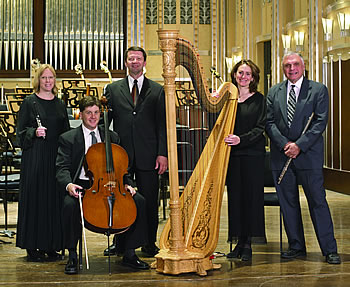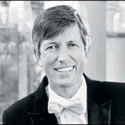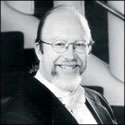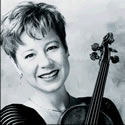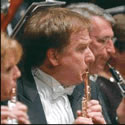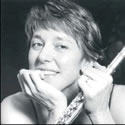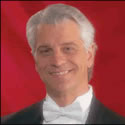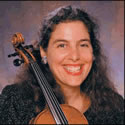
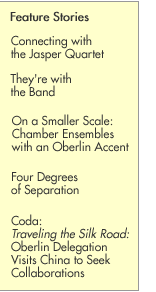 |
|
Home :: Features :: They're With the Band They’re with the Band Orchestral Musicians on Oberlin, on Loving What They Do, and on What Every Young Musician Should Know by Zachary Lewis
Oberlin is famous for expanding the horizons of its students. For Thomas Hemphill ’73, a percussionist with the San Francisco Symphony Orchestra, the expansion was particularly dramatic. Not only did the Conservatory prepare him for a career in an orchestra, it introduced him to classical music. Hemphill has stood amid the San Francisco Symphony’s percussion section for 30 years, some of those as principal. But before entering Oberlin, the Burbank native had been exposed only to rock and jazz. He figured he’d get his degree, head back West, and keep on playing in a band.
Then he heard the Oberlin Orchestra play Beethoven’s Symphony No. 6, the “Pastoral,” with its thrilling evocation of rain and thunder by the timpani. “I remember being blown away,” Hemphill says. “The more I got to know the classical stuff, the more I enjoyed it. None of my original plans materialized.” Studies with Professor of Percussion Michael Rosen and former Oberlin percussion faculty members Peter Kogen and Richard Wiener cemented his interest in “classical stuff.” Before long, Hemphill was happily drowning in it and had joined every student ensemble he could find. One semester, he played a total of 44 concerts. “That was my life. My time at Oberlin was not so much about lessons as about preparing for all those concerts.” Hemphill’s experience is memorable but not unlike those of dozens of other alumni who found their way into major orchestras. Like Hemphill, Donald Miller ’72 never planned to make a living as a classical percussionist. Oberlin opened his eyes to a field he wasn’t aware existed. “I found Oberlin very attractive,” says Miller, who began playing in the Cleveland Orchestra before graduation and is still there. “The Oberlin experience is one of total immersion if you choose it, and I chose it. I still stand here and think, ‘Man, I can’t believe I get to play with these guys.’ I wouldn’t be here had it not been for that saturating experience.”
A few years before Hemphill and Miller arrived at Oberlin, another percussion professor, Cloyd Duff, left an indelible impression on Jack Bell ’66. Bell, former principal percussionist of the Atlanta Symphony Orchestra, describes Duff, who was also timpanist of the Cleveland Orchestra, as “an aristocratic Southern gentleman” who sharpened his technical strengths, developed his musicality, and taught whole pieces rather than excerpts. “I was very fortunate to be one of the last people to study with him,” Bell says. “He was a valuable influence and a lifelong friend. If you can imagine knowledge, supportiveness, and general love for humanity, you have a sense of the atmosphere I lived in before entering the real world.” Indeed, Conservatory graduates have fanned across the country to join the ranks, often as principals, of the best orchestral bands in the land. And they are a close-knit group; find one and that person will know five more. Most say they would not be where they are today without Oberlin, but their reasons for crediting the Conservatory are as diverse as the players themselves.
Robert Ward ’77, associate principal horn of the San Francisco Symphony, remembers a period of marathon music making at Oberlin. “I think my all-time record was 14 hours of playing,” recalls Ward, who came to Oberlin from a small town and found the Conservatory comfortable, not a “music factory,” and an ideal environment for in-depth training from his teacher, Robert Fries, who had been co-principal horn of the Philadelphia Orchestra. Ward pursued an orchestral career because he loved “sitting in the middle of that sound” and has remained in San Francisco since 1980 because his colleagues are “not only great musicians, they’re great people. It’s not a stuffy, elitist experience. We’re really trying to connect with the audience.”
Elizabeth Baker ’76 also settled on the West Coast. A violinist in the Los Angeles Philharmonic, she says orchestral life is a joy. “During my first professional performance, I felt lifted up and carried along because they knew the music so well. I will never forget that exhilaration.” Getting to that point took hours of practice a day and firm direction from her teacher, former Professor of Violin Andor Toth Sr. “He made an invaluable difference in my life. He taught me how to play, how it all worked, and how to buckle down.”
Overall musicality is what Stephen Dinion ’90 gained from his teacher, Michael Rosen. “Almost everything he worked on, even the most technical aspects, seemed to be inspired by interpretive issues,” says Dinion, who has been associate principal percussionist in the Honolulu Symphony Orchestra since 1992. “That has been the most lasting lesson, the one for which I’m most grateful. Hardly a rehearsal, concert, or lesson goes by when I don’t rely on something I learned from him.” The ability to eye the music, the conductor, and her hands simultaneously is a primary skill Trina Struble ’91, assistant principal harpist of the Cleveland Orchestra, took from her studies with Alice Chalifoux. “She was a veritable one-person school for harpists,” Struble says. “The experience was very intense. I would not be in this orchestra were it not for her.” Just before Struble entered the Cleveland auditions, Chalifoux advised, “Go into it expecting to win but don’t expect anything.”
A Preponderance of Flutists Richard Keith Graef ’64, assistant principal flutist of the Chicago Symphony Orchestra, admits he was “probably doing just about everything wrong” when he began at Oberlin and that Willoughby “was very patient with me, going over the fundamentals. He turned my playing around.” He turned it around so far that Graef went on to play in Chicago under conductors Georg Solti and Daniel Barenboim for their full tenures. “It doesn’t get much better than that,” Graef says. “The musical integrity is always amazing.”
Another of Willoughby’s students, Ervin Monroe ’64, principal flutist of the Detroit Symphony Orchestra since 1968, states it even more succinctly: “Oberlin is the reason I’m here.” A native of Florida, Monroe chose Oberlin because he wanted the close attention a smaller school could provide. He got it. Willoughby, he says, helped him in a personal way and made him feel comfortable. “I felt as though he was grooming me and showing me what it was all about. I always hoped I wouldn’t let him down.”
Aralee Dorough ’83, principal flutist of the Houston Symphony Orchestra, applied to both the Juilliard School of Music and the Oberlin Conservatory. She’s glad she went to Oberlin because that’s where she met her future husband, Colin Gatwood ’84, now an oboist in the orchestra. She also encountered Willoughby, who, she says, was “very good at teaching interpretation, explaining how to produce results that would sound spontaneous. He stayed on your case until you got it.” That Willoughby was rigorous might explain why John Rautenberg ’58 was “not extremely happy” with him at first. Now associate principal flutist with the Cleveland Orchestra, Rautenberg had started his Conservatory studies as a music education major seeking a “well-rounded college experience,” rather than an orchestral career. But he came around after realizing how much he’d soaked up from Willoughby “by osmosis, kicking and screaming. It was kind of mysterious, actually, how he did it, but somehow it worked.” Rautenberg ended up touring Europe with the Cleveland Orchestra and its legendary former director, George Szell.
Flute had been the only instrument Mary Kay Fink ’83 played until she transferred to Oberlin. Another of Willoughby’s students, she left Oberlin not only with knowledge of Japanese history and world religions, but with the ability to play Chinese and baroque flutes and “to think and teach myself. I felt completely grounded as a flutist after working with him.” Her training paid off in 1990 when the Cleveland Orchestra announced a piccolo opening. She hadn’t played piccolo, but she quickly picked up the skill and won the audition. Willoughby’s “great talent was that he let the individuality of his students emerge,” says Mark Sparks ’82, principal flutist of the Saint Louis Symphony Orchestra. Willoughby’s approach equipped him for a long orchestral career. “He didn’t crush spirits or try to print out carbon copies of himself. The things I learned from him have only become more useful.”
Many Strings to Their Bows
Amy Leventhal ’78 says she learns a new lesson every day as assistant principal violist of the Atlanta Symphony Orchestra. An active composer, Leventhal describes playing in a fine-tuned musical machine like the ASO under Robert Spano ’83 as being like “living in a compositional laboratory ... I go to work and I hear this unbelievably high level of playing on a daily basis. I hear the writing from the inside and hear what it’s like to produce sound at a high level. I’m rather spoiled.” Leventhal is one of many Oberlin violists in the nation’s top orchestras. Samuel Bergman ’98 is one of the youngest. A member of the Minnesota Orchestra since 2000, Bergman attributes his success to the Oberlin Contemporary Music Ensemble, its director, Timothy Weiss, and former Oberlin professors Jeffrey Irvine and Lynne Ramsey. Irvine, he says, taught “a unique style of viola playing that was relaxed and helped me have less of a death grip on the instrument,” while Ramsey was “upfront about saying you weren’t ready.” Another young, successful Oberlin violist is Daniel Foster ’91, principal violist of the National Symphony Orchestra (NSO). He praises Irvine and Ramsey and notes that he also learned a great deal from Oberlin’s conducting faculty members. “They were teachers,” he says. “They tried to instill in you what you needed to be a good, functioning member of an orchestra. I learned how to have a different standard for myself at Oberlin—how to play at a high level and what it takes to get there.” Foster’s position allows him to work with his father, William Foster ’66, assistant principal violist and a member of the NSO since 1968. “We sit together and get along well,” the elder Foster says. “I admire Daniel’s playing and find it compatible.” While at Oberlin, William Foster spent much of his time playing in a string quartet. He later took the audition in Washington that hooked him on orchestral playing. Although he praised Oberlin to his sons, Daniel and Ben ’89, both made the decision to attend without help from Dad. “They both seriously considered it and saw its merits on their own,” he says. |
